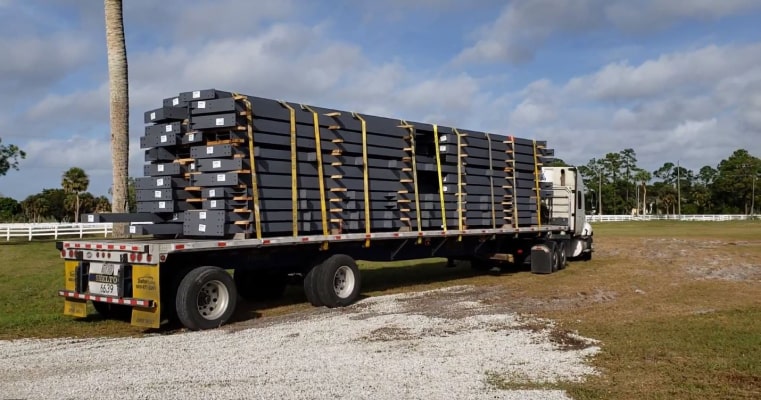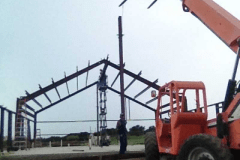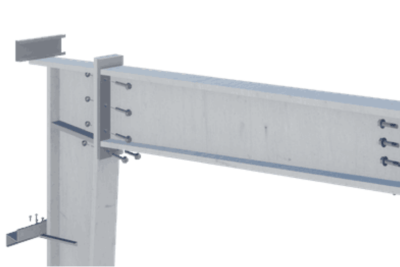Preparing for Delivery and Assembly

You might find it impossible to resist the urge to jump around with excitement when delivery day arrives at last. After countless weeks of planning, prepping, designing, learning, and overcoming obstacles, your new PEB is about to arrive at your building site. What you’ve imagined in your head and drew on paper, is about to become a reality.
Before you allow your excitement to get the best of you, it’s important to take a few particular steps to ensure that the delivery process goes off without a hitch.
Planning Before Delivery
You should make arrangements for the general contractor or erector to be available on the day of delivery. He or she should be placed in charge of verifying that each piece is delivered and in good condition. If you haven’t hired anyone to aid you in the erection process, then you’ll be the one who must ensure that every piece is there and accounted for. Make a list of anything that’s missing or damaged and share it with your building supplier.
When using a general contractor, it’s important to clarify who is going to be in charge of the staging and the off-loading of all the materials. Remember that manufacturers rarely offer equipment or labor to get the pieces off the delivery truck when it pulls into your lot. Make sure to have all of this sorted out before delivery day. Pallet jacks, forklifts, cranes, and other major pieces of equipment might be necessary to complete the staging and unloading, so plan accordingly.
When it comes to laying out your pieces, be sure to consider staging and access. Properties that are flat and large should be easiest to handle. However, if your site is oddly shaped and small, you’ll have to be very considerate about how you unload and organize the pieces of your PEB. The route the truck will take in and out of the property is also another thing to think about.
Take the next step
We have a passion for unconventional solutions that bring your vision to life.
Two Inspections
If you hired a contractor, you and him or her will conduct two different inspections. These are the unloading and unpacking inspections. With the delivery truck still on the property, you’ll conduct the first inspection. The second inspection can be done anytime after.
It’s clear that your PEB is going to arrive in several separate pieces. All of them will be wrapped, boxed, bagged, bundled, and protected in every which way. Dig around in your file drawer to find the inventory list provided by the manufacturer. It’s advisable to make a few extra copies.
Unloading Inspection
You’ll have to give each item a quick inspection as they’re unloaded from the truck. Use the main copy of the packing list throughout this process. For each item you find damaged or missing, make sure to mark it on the list. You’ll use this information to report directly to the carrier while the truck is still there. If you come across any damaged packaging, open it up to see if the contents are damaged as well. The shipment isn’t considered officially delivered until you conduct your unloading inspection, check every item, and provide the approval to the deliverer. This step ensures you get what you need without having to pay extra for replacements or deliveries.
Unpacking Inspection
You can finally start the unpacking process once all of the items have been unloaded, the driver has left, and you’ve finished your inspection. Get ready for an even more scrutinous inspection of the items that were delivered. Grab another copy of the inventory list and start checking off each item once again. Double-check that everything arrived and that it all arrived in the appropriate quantities. You have 30 days to report any more missing or damaged pieces to the building supplier after the unloading inspection.
You might feel as though this second inspection is redundant and time-consuming, but it’s incredibly important to ensure that all of your structure’s parts have arrived intact. Although most manufacturers use advanced technology to make sure that everything is cut perfectly, packaged well, and delivered without any damage, accidents do happen. You’ll be making your building process much easier if you make timely reports and claims.
Staging Materials
You should try and place each component closest to the spot where they’ll be used as possible. You might need to use special equipment to move larger items; all lighter and smaller items should be movable by hand.
Similarly, all columns need to be unloaded close to their final positions near their corresponding anchor bolts. Columns could be set on top of the concrete foundation if wooden blocks are set underneath. To make them easier to lift, it’s smart to keep cables under heavier columns. End Walls can be set towards the side of the slab near their erection point.
In order to keep track of your hardware packages, it’s smart to put them all in one place. You can reduce travel time and improve access by setting all of these items in the middle of the foundation slab.
Be sure to keep girts and purlins away from other pieces. Storing them near sidewalls isn’t a bad idea. You should also keep sheet goods away from other materials since these items are one of the last you’ll be using during the building process. Make sure to add some slope underneath to ensure any condensation or precipitation drains off the panels. Any accessories can also be placed on the side since they’re also some of the last items that will be added once the overall construction is built.
You also want to have the safety of workers in mind when placing items around the lot. Make sure no one is at risk of falling due to the poor placement of an item. You might even have to grab some covers for the pieces depending on the impending weather. This ensures they’re dry and ready to go once construction can commence.
Assembly
You can finally start the exciting building process once everything is delivered on time and intact.
The assembly process might be outsourced to a contractor or erector depending on your capabilities and experience with construction. Each choice comes with some inherent advantages and disadvantages. Considering the pros and cons of each can make it easier to decide and might even convince you of choosing something you didn’t think about before.
Hiring A Contractor
Outside Perspective
One of the major benefits of hiring a contractor is being able to see the actual process getting done. You have an outside and unbiased perspective of the work being done. You won’t be pressured to cut corners or accidentally ignore small mistakes if you performed the assembly yourself. To help the process run as smoothly as possible, you should strive to understand the process overall. Feel free to visit the building of other PEBs in your local area to see how it’s done. Get familiar with the order that things are done in. You could even speak directly to the owner and contractor in charge of the construction. Don’t be afraid to ask questions and tips regarding your project. Watching a project before diving into your own can make the process much easier.
Limiting Liability

Contractors bring experience and expertise to the table, but there’s another major advantage of hiring these professionals to help build your PEB. Upon signing the contract, you’re essentially handing over some of the liability involved with construction over to the contractor. This offers many people extra peace of mind knowing that someone else is involved in the decision-making process.
Working By Yourself
Be Safe

Safety should remain your top priority when entering into construction alone. All contractors have safety plans. Why should you be any different? Learn about the various hazards involved in the process including machinery, terrain, and climate. Be sure to dress appropriately and always wear protective gear when it’s necessary. Always ensure that hired laborers are also wearing protective gear. You’ll want to be mentally and physically strong each day as well.
Separate And Conquer
Many times, breaking down tough jobs into manageable chunks can make the overall process seem much easier. The same is true when it comes to constructing metal buildings. Think about each portion as its very own project. This will make it easier to stay focused. You might even be able to assign these separate jobs to teams, depending on the size of your workforce.
Hire Professionals
Just because you don’t hire a contractor, that doesn’t mean that you can’t use professionals for certain portions of the construction process. Professionals will work safer and more quickly than anyone you could hire. You even save on instruction time since professionals already know what they’re doing.
Keep Tools Handy
There’s a good reason that professionals keep their tools with them at all times. It’s important to keep equipment handy to reduce traveling time and increase the speed at which your building is assembled. When it comes to larger pieces of equipment and tools, you need to make sure these are available for workers as well.
Don’t Deviate From The Plan
If you’ve done your due diligence when creating the construction plan, it should save you time and money if followed correctly. Don’t allow yourself to take any shortcuts in the process. When handling larger projects, you have to ensure that the entire process is mapped out and that every worker keeps a copy handy at all times.
Use Bolts First
Before you raise any panel, be sure to bolt components together. Don’t cut any corners when it comes to safety, but piecing as many parts together as possible before lifting them can help save a lot of time.
Piece-By-Piece
Construct in a natural, progressive manner. Be sure to assemble the framework of each bay before you move to the next.
Rent Wisely
Unless you have access to equipment, you’ll have to rent most of it. You can save money by saving all work that doesn’t require the equipment until after it’s been returned.
Get Enough Sleep
Before leaving the worksite, take time to ensure that everything is safe and secure. Place tools in their designated spots, pick up all of the trash and debris, lock up any entrances, remove tripping hazards, and make sure that all drainage sources are ready to handle any water that may arrive on-site through the night.
You can maintain a safe working space, reduce building costs, and have a successful construction process by following some of these rules.

